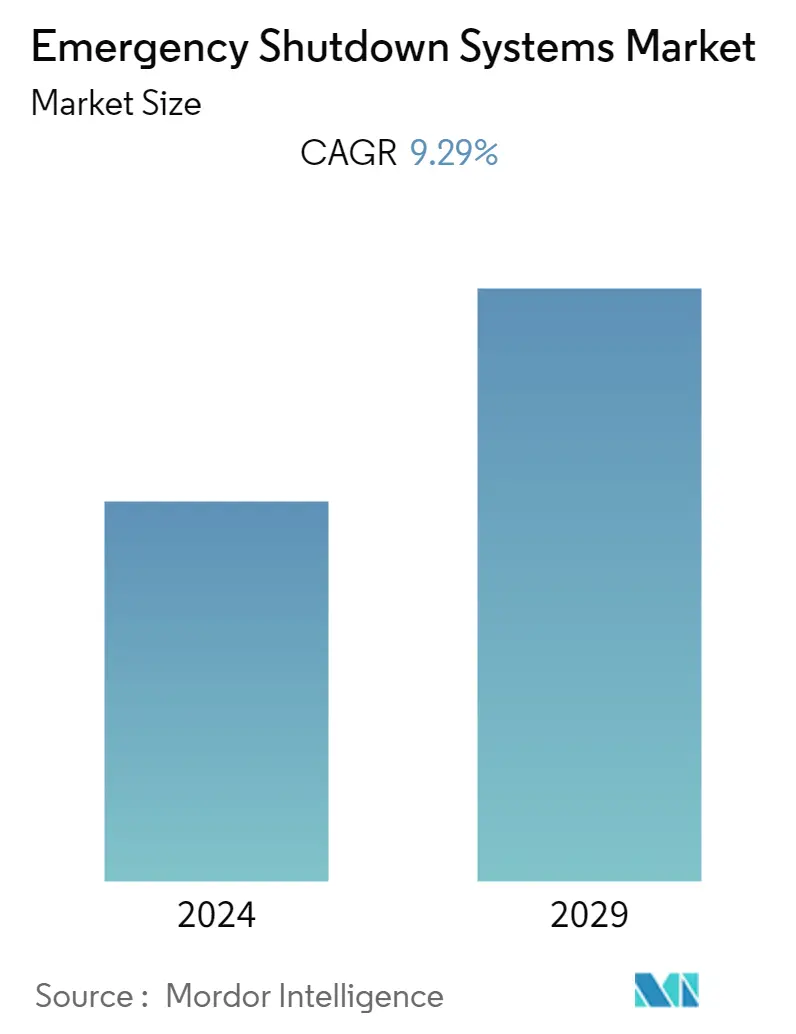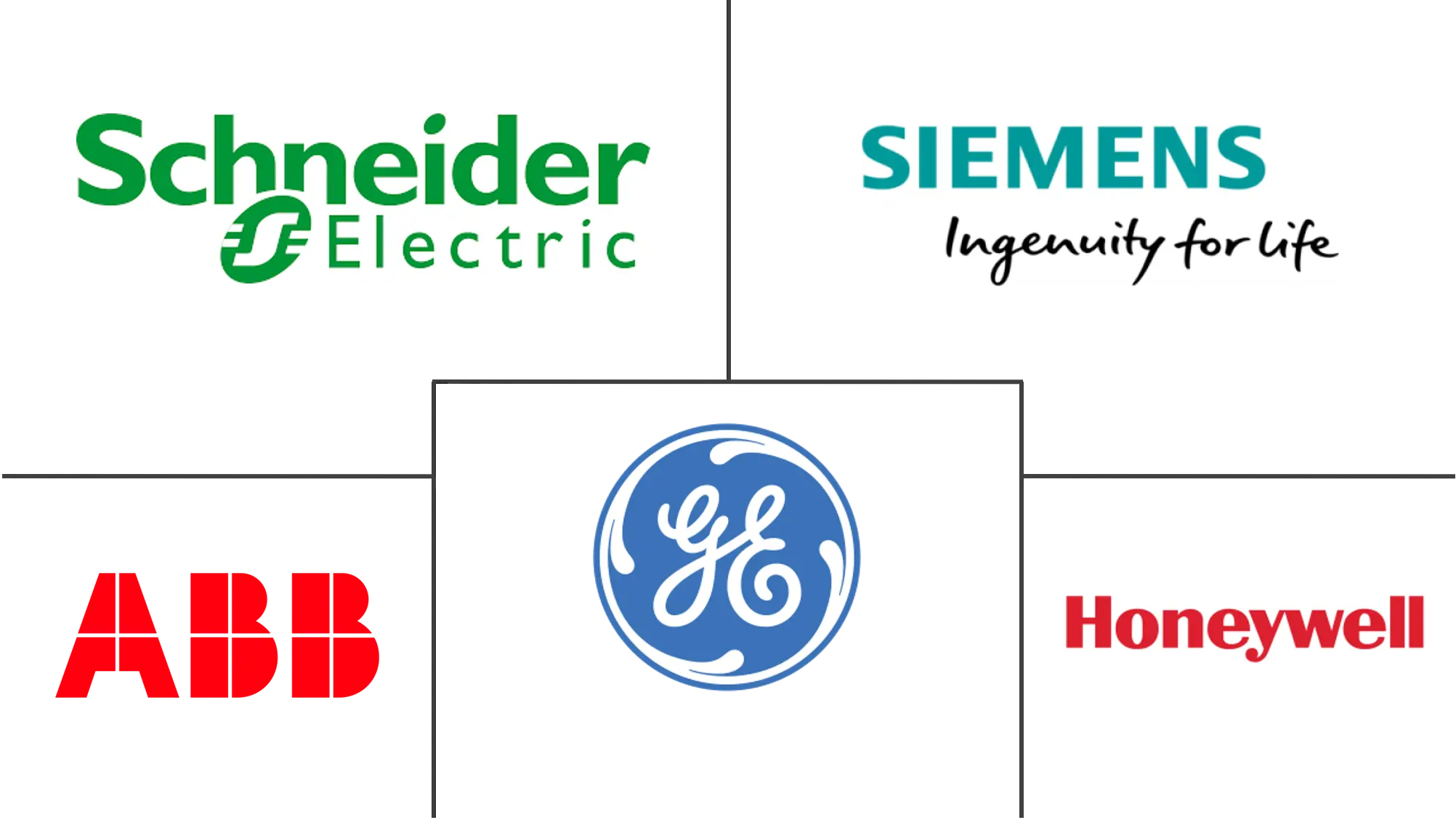Market Size of Emergency Shutdown Systems Industry

| Study Period | 2019 - 2029 |
| Base Year For Estimation | 2023 |
| CAGR | 9.29 % |
| Fastest Growing Market | Asia Pacific |
| Largest Market | Europe |
| Market Concentration | Low |
Major Players
*Disclaimer: Major Players sorted in no particular order |
Emergency Shutdown Systems Market Analysis
The global emergency shutdown systems market was valued at USD 1654.68 million in 2020 and is expected to reach USD 2823.41 million by 2026 and grow at a CAGR of 9.29% over the forecast period (2021-2026). These systems are highly deployed in the oil and gas industry, general manufacturing processes, power generating sector, and several other industries. Out of all the end-users, the oil and gas industry is the largest source of demand for emergency shutdown systems.
- Owing to increasingly complex manufacturing and industrial applications, there has been a rise in the number of global catastrophic accidents. Further, in multiple cases, security factors are also altering the demand for emergency shutdown systems, especially in the case of the oil and gas industry. For example, in countries such as Mexico where the pipelines are often prone to insurgent attacks and theft, there is a high demand for automated and robust emergency shutdown systems, which support remote operation.
- The initial investments associated with the installation of an emergency shutdown system is very high. The total cost of ownership involves capital costs, such as acquisition and design of machines. Wellhead and process emergency shutdown systems are complex and their design has to rely on knowledge from many different disciplines, which accounts for higher design and development costs.
- Moreover, In Apr 2020, Emerson Industrial Energy consulting team was assigned to assist a Northeastern U.S. specialty chemical manufacturer. The latter required modernizing the controls on two of its 1960's vintage Combustion Engineering 'D' Type process steam boilers. The new boiler controls were built by Emerson using DeltaV SIS (Safety Instrumented System) hardware for safety functionality and DeltaV PAS (Process Automation System) equipment for combustion and process control.
- Multiple organizations across the globe are subsequently experiencing a decline in trading conditions primarily owing to the recent outbreak of the COVID-19, further that are also being impacted by the weakening of oil prices.
- The increase in demand is for energy is resulting in the construction of nuclear power plants. It is estimated that over 450 nuclear power reactors are operating in 30 countries and an additional 50 power reactors are currently being constructed in 15 countries (majorly concentrated in countries like China, India, Russia, and the United Arab Emirates). This is anticipated to increase the need for emergency shutdown systems.
Emergency Shutdown Systems Industry Segmentation
Emergency Shutdown Systems (ESD) ensures priority control of process equipment which is required for switching the process in safe mode.
| By Control Method | |
| Electrical | |
| Fiber Optic | |
| Pneumatic | |
| Hydraulic | |
| Other Control Methods |
| By End-user Vertical | |
| Oil and Gas | |
| Refining | |
| Power Generation | |
| Metal and Mining | |
| Paper and Pulp | |
| Other End-user Verticals |
| Geography | |
| North America | |
| Europe | |
| Asia-Pacific | |
| Latin America | |
| Middle East & Africa |
Emergency Shutdown Systems Market Size Summary
The emergency shutdown systems market is experiencing significant growth, driven by its critical application across various industries, particularly in oil and gas, power generation, and manufacturing. These systems are essential for preventing catastrophic accidents and ensuring safety in complex industrial environments. The oil and gas sector remains the largest consumer of these systems, with increasing demand due to the need for robust security measures in regions prone to insurgent attacks and theft. The market is also influenced by the rising construction of nuclear power plants, which necessitates advanced safety systems. Despite the high initial investment and complex design requirements, the market is poised for expansion as industries prioritize safety and regulatory compliance.
Europe stands out as a major market for emergency shutdown systems, fueled by its advanced industrial activities and significant oil refining capacity. The region's focus on expanding existing refineries and initiating new projects, coupled with exploration activities in countries like the United Kingdom, drives the demand for these systems. The adoption of advanced industrial control technologies further supports market growth. Key players in the industry, such as Honeywell, Emerson, and ABB, are investing in technological advancements and strategic acquisitions to maintain a competitive edge. These developments, along with regulatory pressures and the need for safety in offshore and onshore operations, are expected to sustain the market's growth trajectory over the forecast period.
Emergency Shutdown Systems Market Size - Table of Contents
-
1. MARKET DYNAMICS
-
1.1 Market Overview
-
1.2 Market Drivers
-
1.2.1 Stringent Regulatory Policies for Industrial Safety
-
1.2.2 Growing Large-scale Production Projects due to Expansion of Oil and Gas Industry
-
-
1.3 Market Restraints
-
1.3.1 High Initial and Maintenance Costs
-
-
1.4 Industry Value Chain Analysis
-
1.5 Industry Attractiveness Porters Five Force Analysis
-
1.5.1 Threat of New Entrants
-
1.5.2 Bargaining Power of Buyers/Consumers
-
1.5.3 Bargaining Power of Suppliers
-
1.5.4 Threat of Substitute Products
-
1.5.5 Intensity of Competitive Rivalry
-
-
1.6 Technology Snapshot
-
1.6.1 Valves
-
1.6.2 Actuators
-
1.6.3 Field Mounted Safety Sensors
-
1.6.4 System Logic Solvers/Programmable Safety Systems
-
1.6.5 Controllers and Trip Relays
-
1.6.6 Other Components
-
-
-
2. MARKET SEGMENTATION
-
2.1 By Control Method
-
2.1.1 Electrical
-
2.1.2 Fiber Optic
-
2.1.3 Pneumatic
-
2.1.4 Hydraulic
-
2.1.5 Other Control Methods
-
-
2.2 By End-user Vertical
-
2.2.1 Oil and Gas
-
2.2.2 Refining
-
2.2.3 Power Generation
-
2.2.4 Metal and Mining
-
2.2.5 Paper and Pulp
-
2.2.6 Other End-user Verticals
-
-
2.3 Geography
-
2.3.1 North America
-
2.3.2 Europe
-
2.3.3 Asia-Pacific
-
2.3.4 Latin America
-
2.3.5 Middle East & Africa
-
-
Emergency Shutdown Systems Market Size FAQs
What is the current Emergency Shutdown Systems Market size?
The Emergency Shutdown Systems Market is projected to register a CAGR of 9.29% during the forecast period (2024-2029)
Who are the key players in Emergency Shutdown Systems Market?
General Electric Co, Siemens AG, Honeywell International Inc, ABB Ltd and Schneider Electric SE are the major companies operating in the Emergency Shutdown Systems Market.

